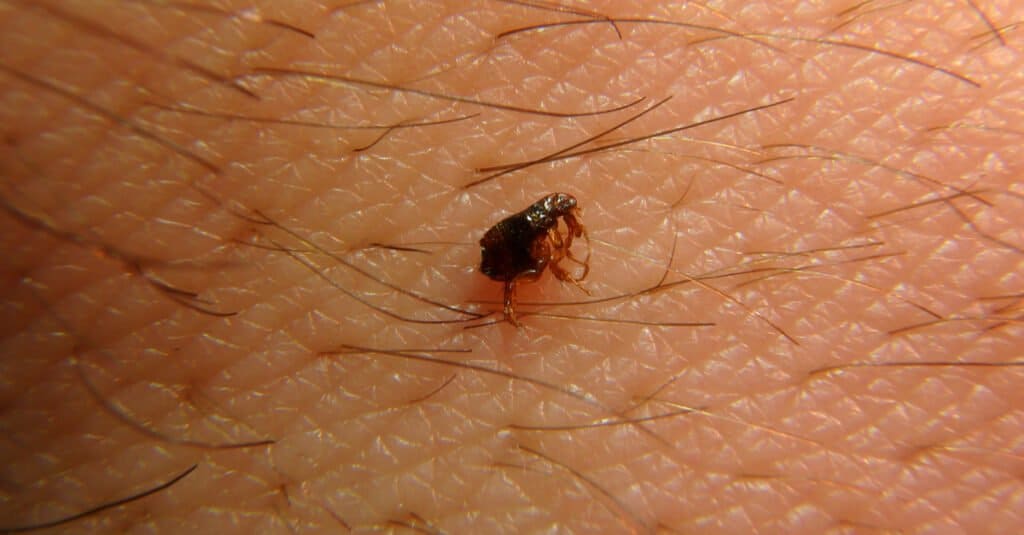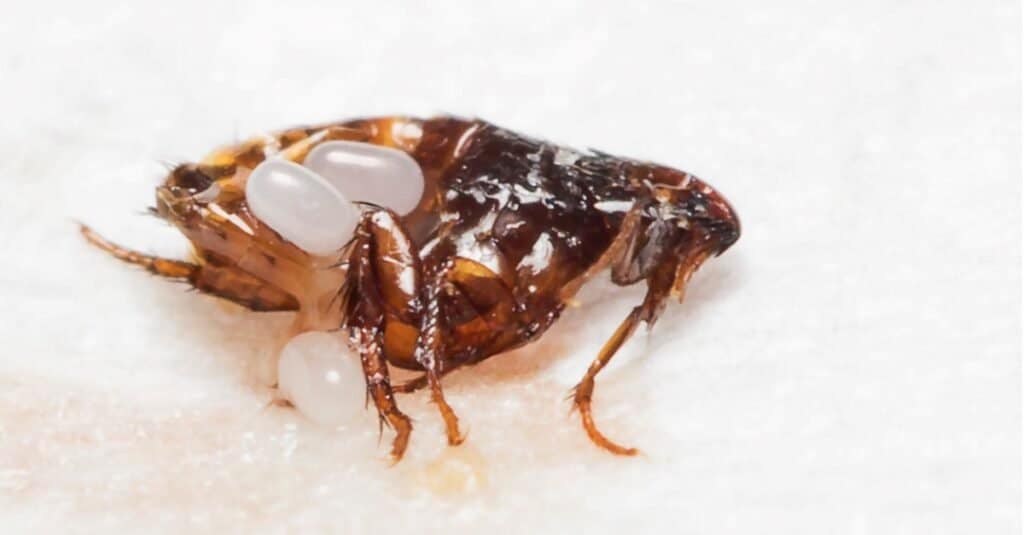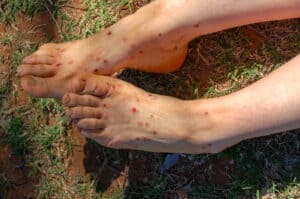Dog lice and fleas are very similar- so much so that it can be difficult for pet owners to tell the two pests apart! But there are some key differences between dog lice vs fleas that should be noted, including their genuses.
For example, dog lice are known as Trichodectes canis, while fleas are known as Ctenocephalides canis. This implies that their species are entirely different.
There are even more differences between these two biting bugs, though you may not be able to tell by looking at them. In order to fully understand the differences between dog lice and fleas, you’ll need to check out various aspects of their lives.
Let’s get started now.
Comparing Dog Lice vs Fleas

| Dog Lice | Fleas | |
|---|---|---|
| Mobility | Slow and attaches to pet hair | Quick and agile jumpers |
| Diet | Animal and human skin flakes | Animal and human blood |
| Lifespan | 2 weeks-1 month | 1-2 months |
| Spread Through | Animal to animal contact | Touching infested areas or pets |
| Reproduction | Lays eggs on animal hair | Lays eggs in undisturbed areas like carpet |
| Appearance | White or tan crawling insects | Small black crawling insects |
The Main Differences Between Dog Lice vs Fleas

Dog lice are light in color, often yellow or white, while fleas are notorious for being dark brown or black bugs.
©Cosmin Manci/Shutterstock.com
There are many key differences between dog lice and fleas, though it can be difficult to tell these differences at first glance. Dog lice are much lighter in color than fleas, often white or creamy tan compared to dark brown or black fleas. Fleas are also much more agile than lice are, capable of jumping extreme distances, while lice prefer to remain attached to animal hair shafts.
But the differences don’t stop there. If you are concerned about the differences between dog lice and fleas, you’re in the right place. Let’s dive into these pests in more detail.

Fleas differ from lice in that they don’t land on an unsuspecting animal until they are fully grown adults, while dog lice remain attached to your family pet for the entirety of their life cycle.
©David Jara Bogunya/Shutterstock.com
Dog Lice vs Fleas: Appearance
One of the main differences between dog lice and fleas comes in the form of their physical appearances. Dog lice are light in color, often yellow or white, while fleas are notorious for being dark brown or black bugs. While you likely can’t tell their main physical differences using the human eye, fleas have a rounded lower half, while lice have a more elongated and uniformly shaped body.
You will recognize a dog lice vs a flea based on the coloring alone. Fleas will appear as small black spots moving around on your pet’s fur, while lice will be small white or yellow bugs attached to the hair itself. Let’s talk more about these pest’s behavior, as this will further help you identify them.
Dog Lice vs Fleas: Behavior and Mobility

Dog lice prefer to eat dead skin cells and skin secretions, while fleas feed off of an animal’s blood exclusively.
©iStock.com/DeVil79
Another difference when it comes to dog lice vs fleas is found in their behavior and mobility. Fleas are well known for their ability to jump and leap great distances; this is not a feature that lice share. Lice are much slower and less capable of jumping when compared to fleas. While this may not seem like a distinct difference, it greatly affects the lifestyles of these two pests.
For example, lice attach to animals via the hair shaft, clinging and living on the hair for the remainder of their life. Fleas are much more mobile, using their jumping ability to move from animal to animal, infested area to infested area. Fleas have a much better chance of surviving than lice do, given their mobility. However, lice are less likely to be noticed right away when compared to the coloring of fleas.
Dog Lice vs Fleas: Diet
Another key difference between dog lice and fleas is their choice of diet and nutrition. Dog lice prefer to eat dead skin cells and skin secretions, while fleas feed off of an animal’s blood exclusively. While both pests leave you and your pets feeling itchy, this is a clear and present distinction to be made between these two bugs.

Lice are much slower and less capable of jumping when compared to fleas.
©iStock.com/FMT Fotografia
Dog Lice vs Fleas: Reproductive Habits
The reproductive habits of dog lice and fleas are very different as well. Dog lice lay their eggs once they have landed on an unsuspecting animal, while fleas prefer to lay their eggs in undisturbed areas, such as carpeting. Fleas also require blood in order to lay their eggs, while lice do not.
Lice attach their eggs to an animal’s hair shaft until they hatch, usually within one to two weeks; flea eggs hatch in a similar timeline, though they can hatch in as little as a few days if conditions are right. Fleas differ from lice in that they don’t land on an unsuspecting animal until they are fully grown adults, while dog lice remain attached to your family pet for the entirety of their life cycle.
Can Dog Lice Infest Your House?
When it comes to parasites, lice are undoubtedly high up on the repulsiveness scale. However, one silver lining to lice is that they are species-specific, meaning that dog lice won’t infest humans and vice versa. To combat a lice infestation in your dog, you can take several steps.
Begin by thoroughly washing bedding, your dog’s collar, and grooming tools, using a solution of water and vinegar.
Be sure to inspect, monitor, and bathe any other pets in the household who might also need treatment. For a natural preventive measure, boil a slice of lemon in water and let it steep overnight.
After bathing your dog, gently apply the lemon-infused water to help deter lice.
Is it Harder to Get Rid of Lice or Fleas?

Various animals can bring fleas into your home, including other dogs.
©Eric Isselee/Shutterstock.com
While neither is an ideal pest, and preventative medications are an extremely important measure to use for your pet, it depends on the infestation. Some think that lice can be harder to get rid of as they attach themselves to your pet’s hair or fur and use their claws to hook into the hair follicles. This can make it rather difficult to remove although there are many insecticides and shampoos that will do a great job of eliminating the lice and their eggs.
Dog lice can not be transmitted to another host. These pests are species-specific and only stay with dogs, just like human lice can not be transmitted to your dog. Fleas on the other hand can bite any warm-blooded mammal, both human and four-legged. While they can’t live on you, they are certainly capable of jumping on you and inflicting bites.
With both pests, you will need to clean all surfaces where your dog lies. Beds, couches, carpets, blankets – although flea removal is more difficult and requires even more than just specific area cleansing, which can also be a very intensive and frustrating removal process. Unlike lice, which might be a bit harder to remove from the source but are easier to clean from your home, fleas will require a complete home cleanse. While no scenario is favored, fleas may be harder to get rid of over lice.
The photo featured at the top of this post is © iStock.com/S.Rohrlach
FAQs (Frequently Asked Questions)
Does flea treatment kill lice on dogs?
Depending on the flea treatment, yes, most commercial flea treatments treat lice on dogs as well. However, you may need to schedule a grooming appointment for your dog to specifically treat lice if you think that your dog has been infected.
Do dog lice and fleas bite humans?
Dog lice prefer to bite only dogs, while fleas will bite both dogs and people. However, even fleas prefer to bite dogs rather than humans, given their ability to hide in a dog’s fur without being noticed. Humans can get bitten by a specific type of lice or louse, but are not likely to be bitten by dog lice.
Thank you for reading! Have some feedback for us? Contact the AZ Animals editorial team.






